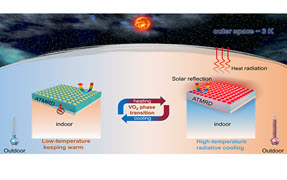Novel organic-sensor concepts
Comfortable, wearable sensors and computers will enhance everyone's awareness of their physical health, environment, chemical pollutants, potential hazards, and other information of interest. Similarly, in agriculture and the food industry, the conditions and needs of plants, animals, and farm products must be monitored constantly. Small and portable sensors are used in real-time control of pollutants in air and water, modern fire-control systems, and many other applications. Unfortunately, there is a significant gap between sensor availability and the increasing demand.
Miniaturization is a key challenge to achieving higher integration levels in optical sensor devices, because it is difficult to find small light sources and detectors. To bridge that gap, we developed a novel sensor concept for optical probes based on electro-optical device architectures, which also offers the advantage of direct incorporation of the receptor/sensor functionalities into the light-emitting layer.
Our research on organic semiconductors resulted in a number of laboratory-scale proof-of-concept sensor devices. These can potentially be used in modern, intelligent integrated sensing systems. Our recently developed devices include organic-LED (OLED) and organic field-effect-transistor (OFET)-based systems: SensLEDs and SensFETs.
Compared to classical luminescent sensor systems, which consist of a light source, a photoluminescent sensing layer, and a detector system, our SensLEDs combine the light source with the sensing element within one layer, thus reducing the fabrication effort: the sensor is incorporated in the organic layer instead of requiring a bipartite structure.1,2 This ‘one-step’ system is a purely electroluminescent assembly. The use of electro- rather than photoluminescence represents the core of our idea (see Figure 1).

To achieve our OLED design, we implemented an analyte-sensitive dye molecule into the electro-active layer of an OLED that is capable of changing its optical properties in the presence of the analyte (during simultaneous change of the overall optical properties of the device itself). To fulfill these demanding prerequisites, the indicator molecule had to exhibit analyte-sensitive properties and be electro-optically active in the device. Specifically, our assembly comprises a glass substrate covered with a 120nm thick indium-tin-oxide layer acting as anode, followed by a 50nm layer of poly(3,4-ethylenedioxythiophene)-polystyrenesulfonic acid. The 70nm thick active sensing layer consists of poly(9-vinylcarbazole) doped with 1% by mass of 2,3,7,8,12,13,17,18-octaethyl-21H,23H-porphyrin platinum (II). Finally, 150nm thick and 150 mm wide electrodes were evaporated on the top to serve as the cathode.1
We also developed an OFET-based design, referred to as a SensFET. Sensor concepts based on the bottom-gate OFET architecture with the active organic semiconducting film as sensing layer (as often applied in the literature), have a number of disadvantages. First, when operated in an ambient atmosphere, the organic semiconducting layer is directly exposed to moisture and oxygen, which may reduce the sensor's selectivity and sensitivity. Second, the semiconducting film's morphology strongly determines its response to analytes. In addition, since the defect density might change between experiments because of material degradation or slight variations of the processing conditions and/or the substrate and material quality, reproducible results are often difficult to attain.
In contrast, our transducer concept is based on the top-gate OFET architecture, where we use the bulk of the gate dielectric—either pure or a matrix composed of a host and a sensing guest material—as the sensitive part.3,4 Upon exposure to a gaseous or aqueous analyte or light, the overall dielectric constant of the specifically tailored sensitive insulating layer changes, which in turn alters the device characteristics. Figure 2 shows the corresponding sensor structure with a comb-shaped gate, allowing the analyte to make contact with the dielectric.

For future work in SensLEDs, we aim to facilitate easy fabrication, simplify the sensing element's structure, and allow its integration with other elements, such as photovoltaic cells. For SensFETs, we are currently developing a series of different sensor devices.
Emil List received his doctorate in 2000 from TU Graz and his ‘Habilitation’ in solid-state physics in 2003, when he was appointed associate professor. Since 2007 he has been the scientific managing director of the NanoTecCenter Weiz, a research institute focusing on applied research related to organic semiconductors and coating technologies.



